
The description of the divide-and-conquer algorithm is easy to understand literally. Divide and conquer actually involve a merging process:
Divide: Recursively solve smaller problems (stop when reaching the termination layer or when it can be solved)
Conquer: Solve recursively, or solve directly if the problem is small enough.
Combine: Construct the solution of the sub-problem into the parent class problem
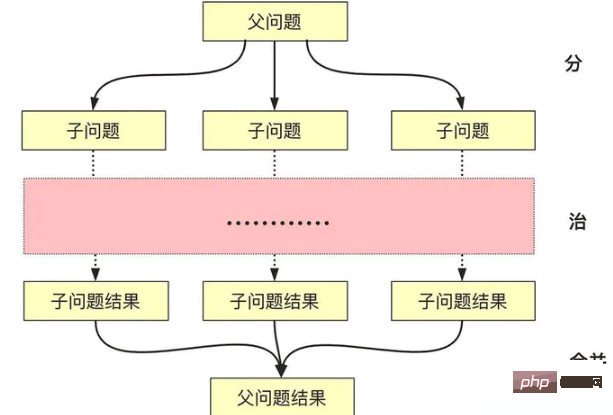
So what conditions (characteristics) need to be met for problems solved by the divide-and-conquer algorithm?
3. Classic Problems of the Divide and Conquer Algorithm
The classic problem of the divide-and-conquer algorithm is divided into two categories: sub-problems are completely independent and sub-problems are not completely independent.
public int searchInsert(int[] nums, int target) {
if(nums[0]>=target)return 0;//剪枝
if(nums[nums.length-1]==target)return nums.length-1;//剪枝
if(nums[nums.length-1]target) {
right=mid;
}
else {
left=mid+1;
}
}
return left;
} Quick sort is also an example of divide and conquer. Each pass of quick sort will select a number, and put the number smaller than this number on the left, and the number larger than this number on the right. , and then recursively divide and conquer to solve the two sub-intervals. Of course, quick sort does a lot of work when dividing. When all the parts are at the bottom, the value of this sequence is the sorted value. This is a manifestation of divide and conquer.
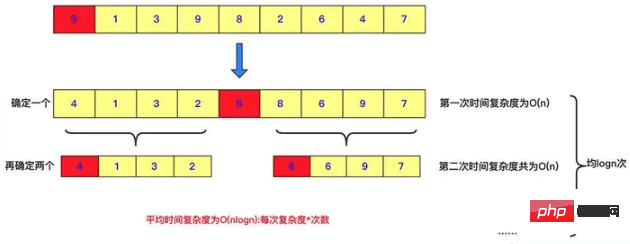
public void quicksort(int [] a,int left,int right)
{
int low=left;
int high=right;
//下面两句的顺序一定不能混,否则会产生数组越界!!!very important!!!
if(low>high)//作为判断是否截止条件
return;
int k=a[low];//额外空间k,取最左侧的一个作为衡量,最后要求左侧都比它小,右侧都比它大。
while(low=k)//右侧找到第一个小于k的停止
{
high--;
}
//这样就找到第一个比它小的了
a[low]=a[high];//放到low位置
while(low3.3. Merge sort (reverse order)
Quick sort does a lot of work when dividing, and merging is the opposite. When merging, they are evenly divided according to the number, and when merging, they are already merged in an orderly manner, because the required results can be obtained with the O(n) level complexity of two ordered sequences. The deformation of reverse ordinal numbers based on merge sorting is also solved by the divide and conquer idea.
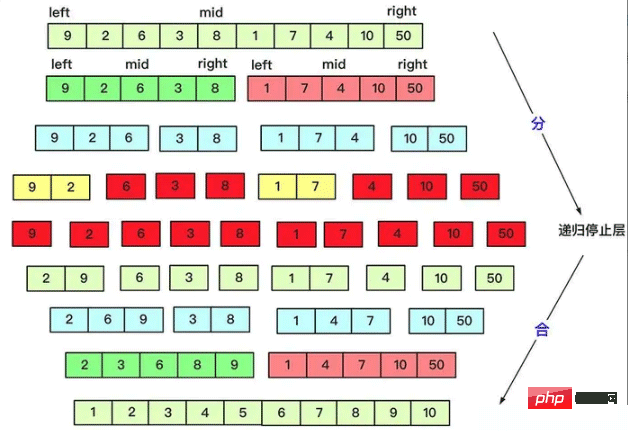
private static void mergesort(int[] array, int left, int right) {
int mid=(left+right)/2;
if(left3.4. We can use dynamic programming to solve the problem of maximum subsequence and
maximum sum of subsequences, but we can also use the divide-and-conquer algorithm. Solve the problem, but the maximum subsequence sum is not a simple merge when merging, because the subsequence sum involves a length problem, so the correct results are not necessarily all on the leftmost or rightmost, but the area where the result may appear For:
completely to the left of the center
completely to the right of the center
A sequence containing the left and right nodes in the middle
can be represented by a graph as:
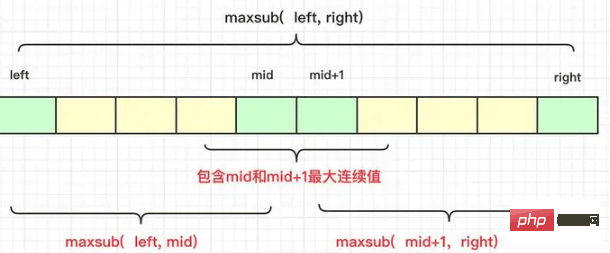
Therefore, when considering it specifically, it is necessary to calculate the result of the maximum value string in the middle that cannot be obtained recursively to participate in the comparison between the left and right sides.
The code for the maximum subsequence sum is:
public int maxSubArray(int[] nums) {
int max=maxsub(nums,0,nums.length-1);
return max;
}
int maxsub(int nums[],int left,int right)
{
if(left==right)
return nums[left];
int mid=(left+right)/2;
int leftmax=maxsub(nums,left,mid);//左侧最大
int rightmax=maxsub(nums,mid+1,right);//右侧最大
int midleft=nums[mid];//中间往左
int midright=nums[mid+1];//中间往右
int team=0;
for(int i=mid;i>=left;i--)
{
team+=nums[i];
if(team>midleft)
midleft=team;
}
team=0;
for(int i=mid+1;i<=right;i++)
{
team+=nums[i];
if(team>midright)
midright=team;
}
int max=midleft+midright;//中间的最大值
if(max3.5. Nearest point pair
The nearest point pair is a very successful divide and conquer method One of the applications. There are several point coordinates on the two-dimensional coordinate axis, allowing you to find the distance between the two nearest points. If you are asked to find it directly, enumeration violence is a very, very large amount of calculation. We usually use the divide and conquer method to optimize This kind of problem.
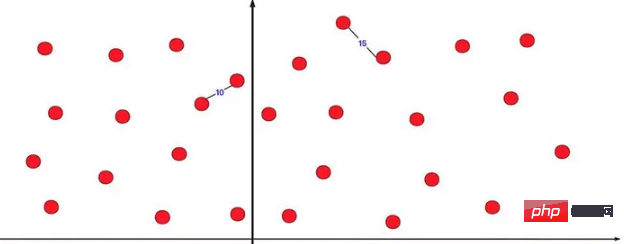
If you directly divide it into two parts and calculate the divide and conquer, you will definitely find that if the shortest one is on the left and the other on the right, there will be a problem. We can optimize it.
In terms of the specific optimization plan, consider the x or y dimension, divide the data into two areas, and first calculate (according to the same method) the shortest point pairs in the left and right areas respectively. Then cover it to the left and right according to the shorter distance between the two, calculate the distance between the covered left and right points, find the smallest distance and compare it with the current shortest distance.

In this way, you can find that in this one-time operation (regardless of sub-cases), the red point on the left avoids distance calculation with most of the red points on the right (O (time complexity of n2)). In fact, when performing internal calculations in the left and right intervals, it actually performs many divide-and-conquer calculations recursively. As shown in the figure:
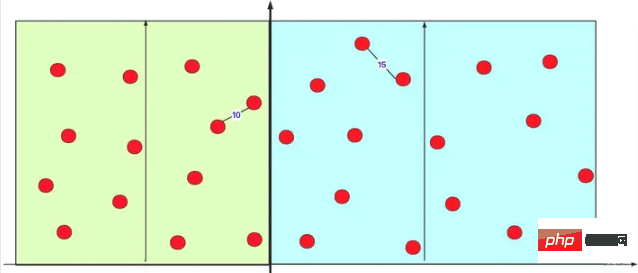
# This can save many calculations.
However, there is a problem with this kind of divide and conquer. The two-dimensional coordinates may have points clustered on a certain method and a certain axis, so the effect may not be obvious (the points are all near x=2 and have no effect on x division). Large), you need to pay attention to it. The code for
ac is:
import java.io.BufferedReader;
import java.io.IOException;
import java.io.InputStreamReader;
import java.io.OutputStreamWriter;
import java.io.PrintWriter;
import java.io.StreamTokenizer;
import java.util.ArrayList;
import java.util.Arrays;
import java.util.Comparator;
import java.util.List;
public class Main {
static int n;
public static void main(String[] args) throws IOException {
StreamTokenizer in=new StreamTokenizer(new BufferedReader(new InputStreamReader(System.in)));
PrintWriter out = new PrintWriter(new OutputStreamWriter(System.out));
//Listlist=new ArrayList();
while(in.nextToken()!=StreamTokenizer.TT_EOF)
{
n=(int)in.nval;if(n==0) {break;}
node no[]=new node[n];
for(int i=0;i=left) {ll--;}
while(no[rr].y-no[mid].y<=Math.sqrt(minleng)/2&&rr+1<=right) {rr++;}
for(int i=ll;iminleng) {continue;}
else
{
team=(no[i].x-no[j].x)*(no[i].x-no[j].x)+(no[i].y-no[j].y)*(no[i].y-no[j].y);
if(teamcom=new Comparator() {
@Override
public int compare(node a1, node a2) {
// TODO 自动生成的方法存根
return a1.y-a2.y>0?1:-1;
}};
static class node
{
double x;
double y;
public node(double x,double y)
{
this.x=x;
this.y=y;
}
}
} The above is the detailed content of Java algorithm design and analysis: detailed explanation of divide-and-conquer algorithm examples. For more information, please follow other related articles on the PHP Chinese website!